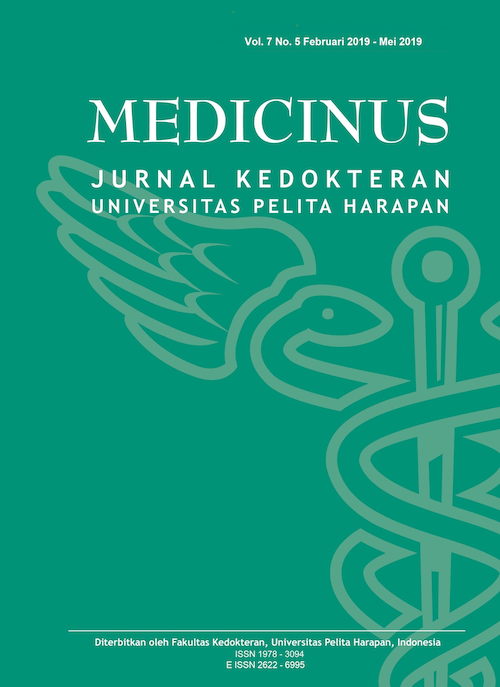Management of Autoimmune Hemolytic Anemia in the Midst of Coronavirus Disease 2019 Pandemic: A Case Report
DOI:
https://doi.org/10.19166/med.v7i7.2761Keywords:
Autoimmune Hemolytic Anemia, AIHA, Covid-19,Abstract
Introduction : The novel coronavirus disease 2019 (COVID-19) has become a pandemic involving all people and can be severe and life-threatening in a certain population such as those with comorbidity. Autoimmune hemolytic anemia (AIHA) is an autoimmune hematologic disease characterized with antibodies production that binds to red cell surface antigens. In this pandemic, several concerns have been raised by autoimmune disease clinicians and patients regarding the use of immunosuppressive drugs. In this case report, we illustrate the problems of autoimmune hemolytic anemia patient when she got active case.
Case Illustration : A 28 years old lady was admitted to the hospital owing to fatigue and tiredness during exercise for two weeks. She had been diagnosed with autoimmune hemolytic anemia before and did not comply with the treatment. This patient has been reevaluated of having AIHA from the symptoms of fatigue, enlarged spleen, low hemoglobin, increased reticulocytes, signs of hemolytic in blood smear examination, increased indirect bilirubin, LDH and the Combs’ test result was given positive. She received methylprednisolone 2 mg/kg of body weight intravenously, washed packed red cells (PRC), calcium and proton pump inhibitor. She was discharged at the seventh day since admission and she was prescribed oral methylprednisolone equal to 1 mg/kg body weight.
Conclusion : This is an educated case of non-compliance of AIHA that should be given high dose steroid and blood transfusion during hospitalization amid the COVID-19 pandemic. The recommendation of treatment for AIHA was still the same as before the pandemic occured.
References
1. Worldometers. Coronavirus Disease 2019 [Internet]. [Update 2020 May 14th, cited 2020 May 15th]. Available from: https://www.worldometers.info/coronavirus/
2. Zhou E, Yu T, Du R, Fan G, Liu Y, Liu Z, et al. Clinical course and risk factors for mortality of adult inpatients with COVID-19 in Wuhan, China: A retrospective cohort study. Lancet. 2020 Mar 28;395(10229):1054-62. Epub 2020 Mar 11. https://doi.org/10.1016/S0140-6736(20)30566-3
3. Chaudhary RK, Das SS. Autoimmune hemolytic anemia: from lab to bedside. Asian J Transfus Sci. 2014 Jan-Jun;8(1):5-12. PMCID: 3943148. PMID: 24678166. https://doi.org/10.4103/0973-6247.126681
4. Contentti EC, Correa J. Immunosuppression during the COVID-19 pandemic in neuromyelitis optica spectrum disorders patients: A new challenge. Mult Scler Relat Disord. 2020 Jun;41:102097. PMCID: PMC7131249. PMID: 32278860. https://doi.org/10.1016/j.msard.2020.102097
5. Fan BE, Ong KH, Chan SSW, Young BE, Chong VCL, Chen SPC, et al. Blood and blood product use during COVID-19 infection. Am J Hematol. 2020 Apr 12. [Epub ahead of print]. PMID: 32279352. https://doi.org/10.1002/ajh.25823
6. Barcellini W, Fattizzo B. Clinical implications of hemolytic markers in the differential diagnosis and management of hemolytic anemia. Disease markers. 2015. https://doi.org/10.1155/2015/635670
7. Go RS, Winters JL, Kay NE. How I treat autoimmune hemolytic anemia. Blood 2017 June 129(22):2971-9. https://doi.org/10.1182/blood-2016-11-693689
8. American Society of Hematology COVID-resources. COVID-19 and ITP: Frequently asked questions. [version 2.0; last updated April 24, 2020; cited on May 15th 2020]. Available from: https://www.hematology.org/covid-19/covid-19-and-itp
9. World Health Organization. Coronavirus disease (COVID-19) advice for the public. [cited May 17th, 2020]. Available from: https://www.who.int/emergencies/diseases/novel-coronavirus-2019/advice-for-public
Downloads
Published
How to Cite
Issue
Section
License
Copyright (c) 2020 Andree Kurniawan, Devina Adella Halim

This work is licensed under a Creative Commons Attribution-ShareAlike 4.0 International License.
Authors who publish with this journal agree to the following terms:
1) Authors retain copyright and grant the journal right of first publication with the work simultaneously licensed under a Creative Commons Attribution License (CC-BY-SA 4.0) that allows others to share the work with an acknowledgement of the work's authorship and initial publication in this journal.
2) Authors are able to enter into separate, additional contractual arrangements for the non-exclusive distribution of the journal's published version of the work (e.g., post it to an institutional repository or publish it in a book), with an acknowledgement of its initial publication in this journal.
3) Authors are permitted and encouraged to post their work online (e.g., in institutional repositories or on their website). The final published PDF should be used and bibliographic details that credit the publication in this journal should be included.





